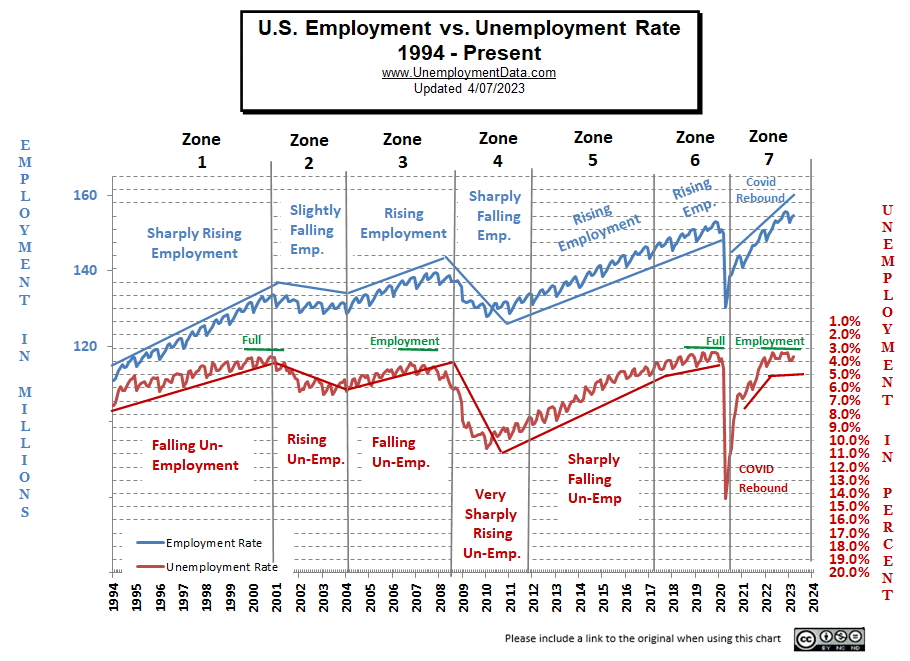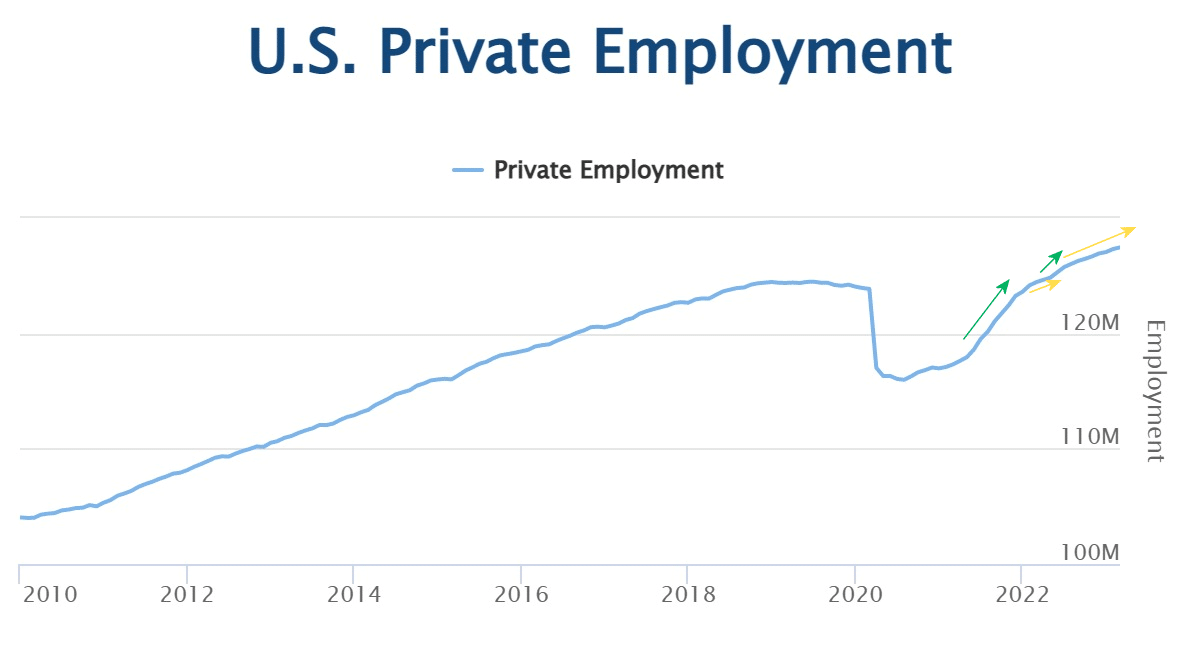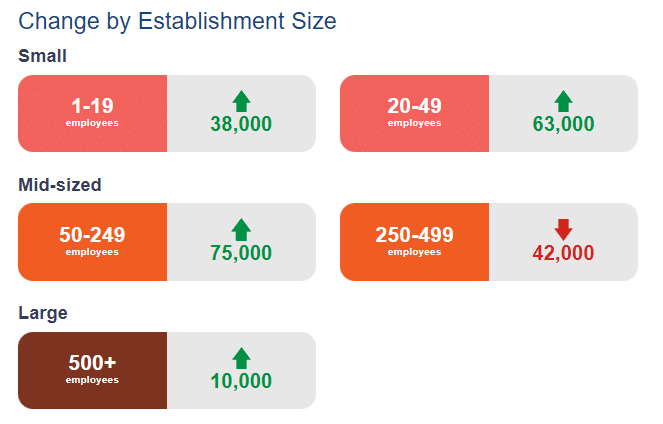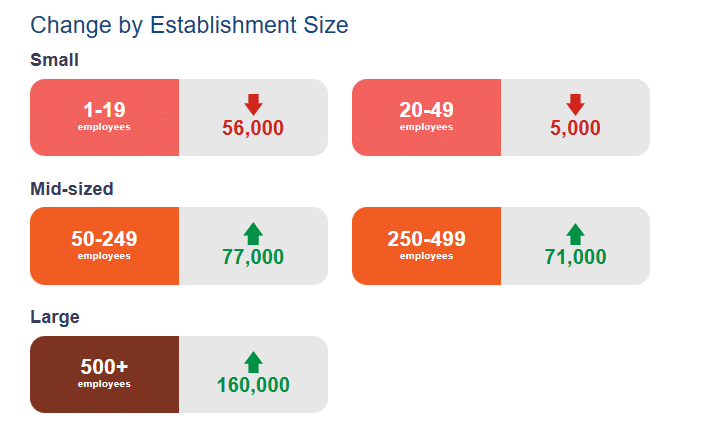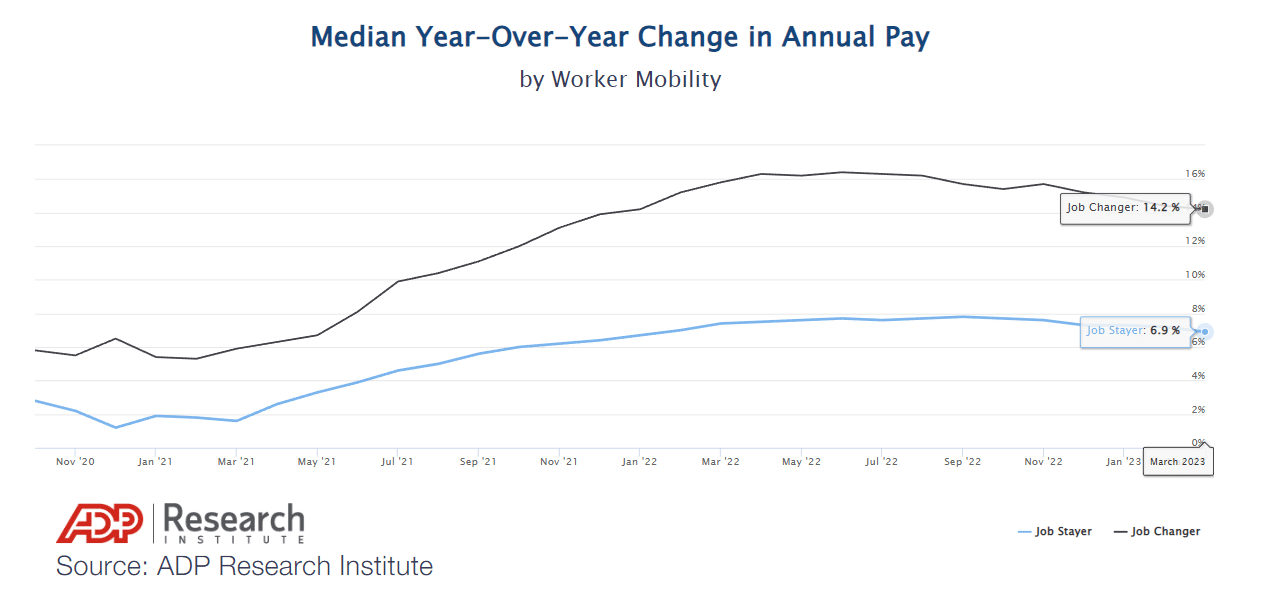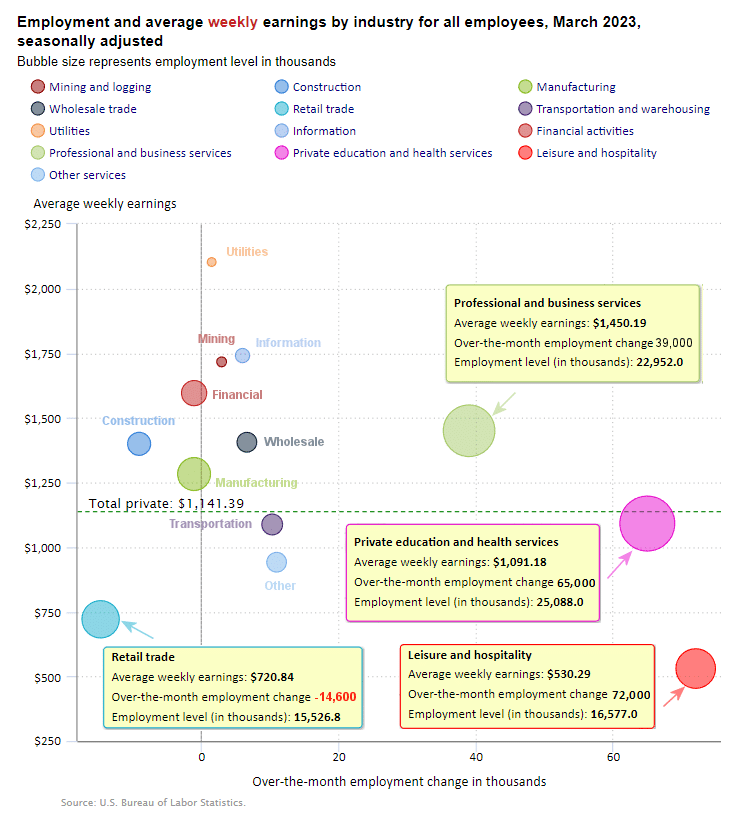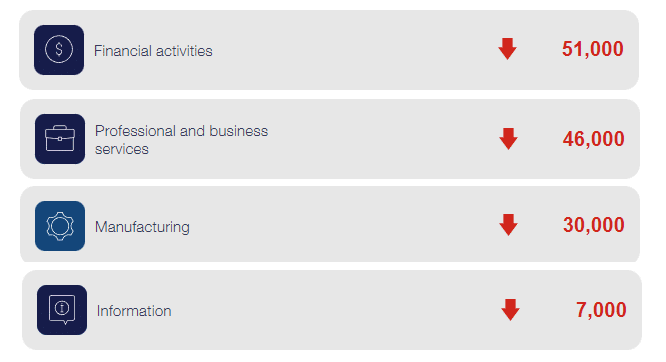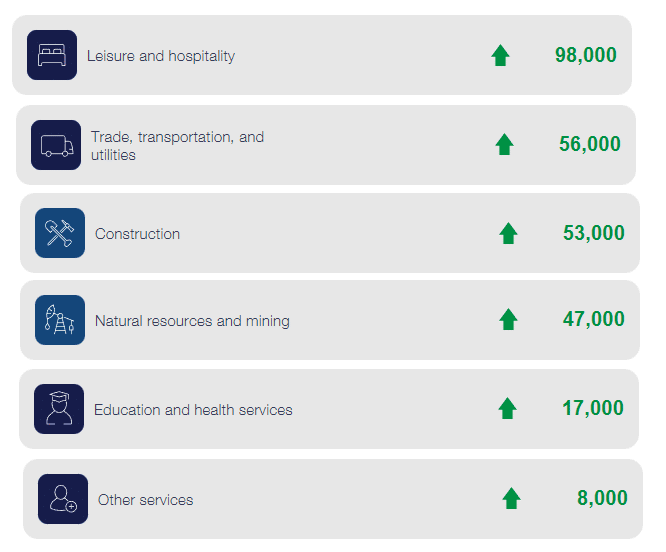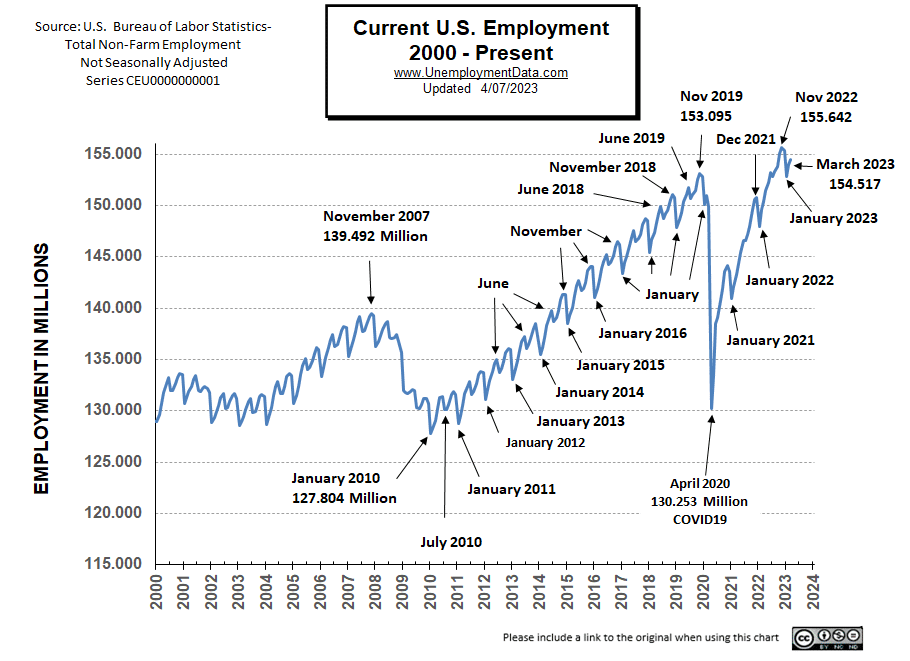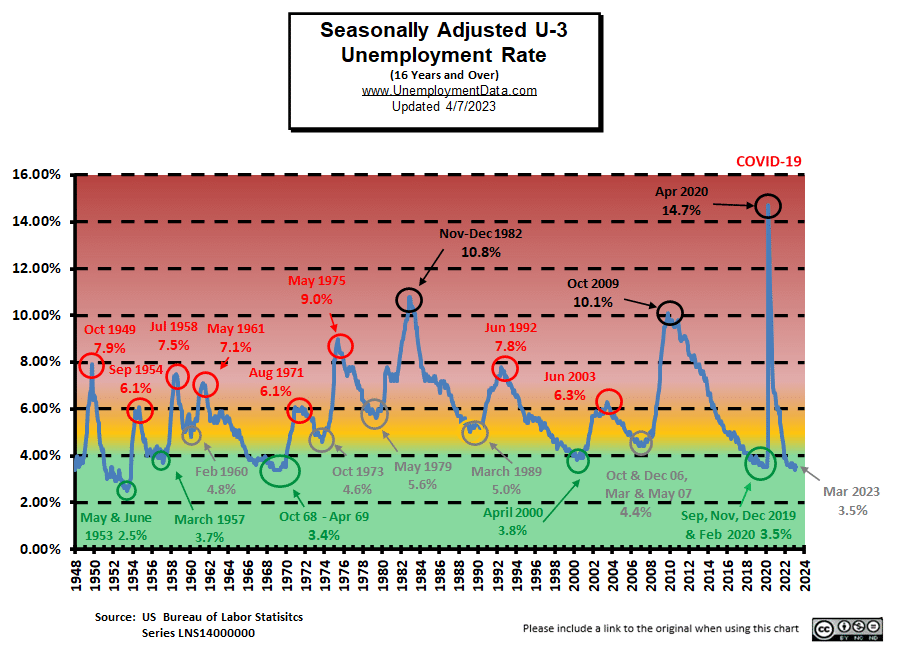The U.S. Bureau of Labor Statistics (BLS) released its employment / unemployment report for March on April 7th 2023.
Employment Up and Unemployment Down
![]()
- Adjusted U-3 was 3.5% down from 3.6%
- Unadjusted U-3 was 3.6% down from 3.9%
- Unadjusted U-6 was Down from 7.3% to 6.8%
- Labor Force Participation Up from 62.5% to 62.6%
- Unadjusted Employment rose from 153.997 to 154.517 million
According to the Commissioner of the U.S. Bureau of Labor Statistics:
“Total nonfarm payroll employment rose by 236,000 in March, and the unemployment rate changed little at 3.5 percent, the U.S. Bureau of Labor Statistics reported today.
Employment continued to trend up in leisure and hospitality, government, professional and business services, and health care.”
You can read the full BLS report here.
As usual, they are talking about “Seasonally Adjusted Jobs”.
Looking at the Establishment Survey report we see…
Originally the BLS reported employment of 153.955 million for February which they adjusted to 153.997 million. So they added 42,000 jobs for February. They are reporting 154.517 million jobs for March which is actually an increase of 562,000 jobs based on their original estimates or an increase of 520,000 based on their updated numbers.
Full Employment?
Full Employment is when everyone who wants a job has one. It is generally considered to be slightly above 3%. Although, other factors, such as unemployment benefits, can shift the level higher or lower. So, if unemployment benefits are extended from 6 months to 1 year, people will tend to stay unemployed longer, thus raising the unemployment rate.
In the following chart, we can see four examples of employment continuing to rise, but unemployment flattens out at just over 3%.
Full employment is not considered to be at zero percent because even when employers are having difficulty finding employees, some people are still unemployed due to either structural unemployment (mismatch between worker skills and job requirements, i.e., not enough training) or simply because they quit their job knowing it would be easy to find another (hopefully better) job. Often referred to as frictional unemployment (there will always be people who have quit or have lost a seasonal job and are in the process of getting a new job). See: Highly Skilled Worker Shortage in a Recession?
If the unemployment rate stays constant, but more people are working, where are these extra workers coming from?
Somehow the workforce has to be growing to accommodate these newly created jobs. They could be long-term unemployed (no longer counted in the workforce) returning to the workforce, they could be immigrants entering the workforce, or possibly retired people coming out of retirement because of an offer too good to turn down.
ADP® National Employment Report
According to ADP® In collaboration with Stanford Digital Economy Lab, private employment was up in March.
ADP: Private employers added 145,000 jobs in March.
In other words, Ms. Richardson is saying that a 145,000 increase in jobs is not as high as she would have expected for a March with strong growth. And “pay growth” has plateaued and decreased slightly. Last month, “Job stayers” averaged a 7.2% annual increase in pay, while this month, the average annual increase is down to 6.9%.
I’ve added some arrows to their private employment chart to indicate the slope of the line. The long green arrow shows the rapid post-COVID rebound in employment. Then in early 2022, the rate of increase slowed (small yellow arrow). Then around March 2022, the rate of increase picked up again (small green arrow). Perhaps, that is what Ms. Richardson was expecting. But instead, we’ve seen steady growth without the turbo boost of last year.
ADP Private Employment by Firm Size
ADP also lists increases by “firm size”.
This month, small companies are reversing the downsizing they did last month, while larger companies cut way back on their hiring.
March ADP Changes:
Comparing March changes to February changes we can see that increases shifted from large firm hiring to small firm hiring.
February ADP Changes:
ADP Also Tracks Salary Changes:
As you would expect in a tight labor market, “Job Changers” saw a much greater increase in salary than those who stayed in their job, as companies needed to offer significant increases in order to attract new employees.
Source: ADP® Pay Insights
March 2023 Employment by Sector
The employment “bubble chart” is a quick and easy way to see how each sector performs on a seasonally adjusted basis. The Bubble’s Size tells us the total Employment for that industry (i.e., larger bubbles mean more people are employed in that sector).
The bubble’s location on the chart tells us that there has been a change in Employment Levels over the most recent month… A bubble further to the right indicates larger job growth. A bubble’s vertical location on the chart shows the average industry salary.
Average Weekly Wages
Although ADP says wages increased year over year by 6.9%, the BLS says average wages decreased by a few cents in March.
| Date | Average Weekly Wage |
| March 2023 | $1,141.34 |
| February 2023 | $1,141.61 |
| January 2023 | $1,146.14 |
| December 2022 | $1,125.73 |
| November 2022 | $1,129.01 |
| October 2022 | $1,124.01 |
| September 2022 | $1,119.87 |
| August 2022 | $1,116.42 |
| July 2022 | $1,116.54 |
| June 2022 | $1,106.76 |
| May 2022 | $1,105.47 |
| April 2022 | $1,102.01 |
| December 2021 | $1,086.46 |
Remember, these are Seasonally Adjusted Numbers, so they aren’t cumulative!
BLS Employment and Average Weekly Earnings by Industry
March 2023, Seasonally Adjusted Employment
We’ve added another column to the table below that shows the employment levels that the BLS reported the previous month. Note that due to “seasonal adjusting,” although they may claim that there was a “monthly increase” (or decrease), there isn’t always a real increase; you can’t just subtract last month’s “employment level” from this month’s level. For instance, Mining was supposed to have 635,000 employees in March and have a 3,000 “increase”, but in February, there were 631,000 employed. That looks like a 4,000 “increase” to me. And Financial was supposed to have a -1,000 decrease but went from 9,105,000 in February to 9,098,000 in March, which looks like -7,000 to me.
| Industry | March Monthly Increase | Mar. Ave. Weekly Earnings | Employment Level March | Employment Level February |
| Total Private Employment | 189,000 | $1,141.39 | 133,012,000 | 132,855,000 |
| Mining and Logging | 3,000 | $1,716.76 | 635,000 | 631,000 |
| Construction | -9,000 | $1,399.62 | 7,888,000 | 7,918,000 |
| Manufacturing | -1,000 | $1,282.75 | 12,983,000 | 12,983,000 |
| Wholesale trade | 6,700 | $1,405.72 | 6,055,300 | 6,048,800 |
| Retail trade | -14,600 | $720.84 | 15,526,800 | 15,561,800 |
| Transportation and Warehousing | 10,400 | $1,087.55 | 6,726,500 | 6,699,700 |
| Utilities | 1,500 | $2,102.90 | 554,000 | 552,100 |
| Information | 6,000 | $1,740.95 | 3,093,000 | 3,075,000 |
| Financial Activities | -1,000 | $1,595.86 | 9,098,000 | 9,105,000 |
| Professional and Business Services | 39,000 | $1,450.19 | 22,952,000 | 22,912,000 |
| Private Education and Health Services | 65,000 | $1,091.18 | 25,088,000 | 25,008,000 |
| Leisure and Hospitality | 72,000 | $530.29 | 16,577,000 | 16,535,000 |
| Other Services | 11,000 | $941.53 | 5,835,000 | 5,826,000 |
Source: BLS
Note: As usual, ADP has an entirely different picture. BLS says Construction, Manufacturing, Retail and Financial lost jobs, ADP says Financial, Professional, Manufacturing and Information lost jobs.
ADP Job Losers
ADP Job Gainers
Unemployment
March’s Seasonally Adjusted Unemployment is 3.5%, down from 3.6% in February.
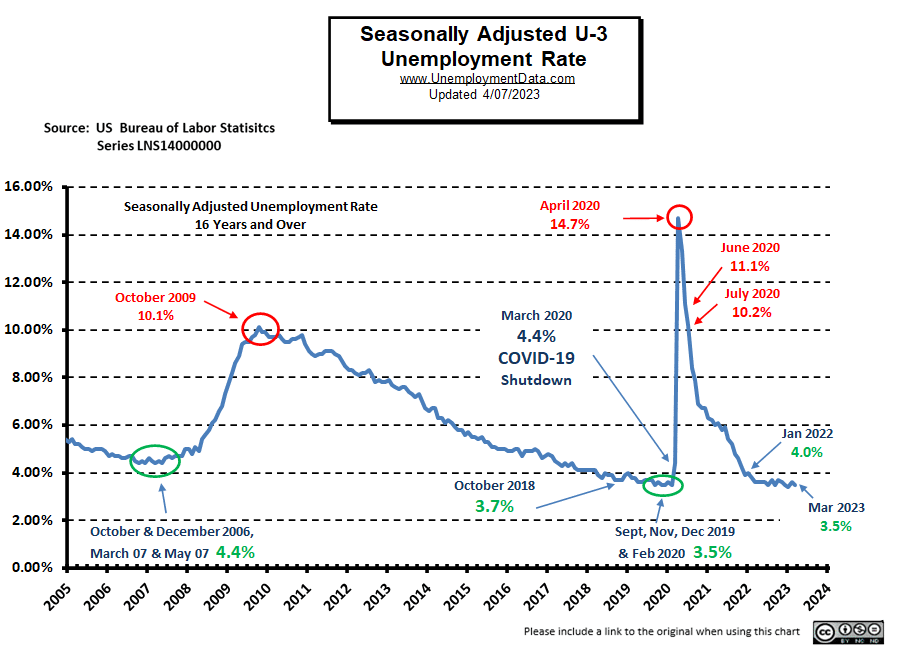 See Unemployment Rate Chart for more information.
See Unemployment Rate Chart for more information.
Current Employment Rate Chart
Typically the low point for each year occurs in January. Then employment moves almost straight up to a small peak around June with a slight drop around July, and then the highest peak in employment happens in November or December.
See Current Employment for more info.
Unemployment Still Historically Low
Unemployment levels are still in the historically low territory. After all, the FED did pump unprecedented TRILLIONS into the economy to get us to this place.
See: FED Actions for more info.
But we can see that Seasonally Adjusted U-3 is definitely in the “Green” territory.
March 2023 Labor Force Participation Rate
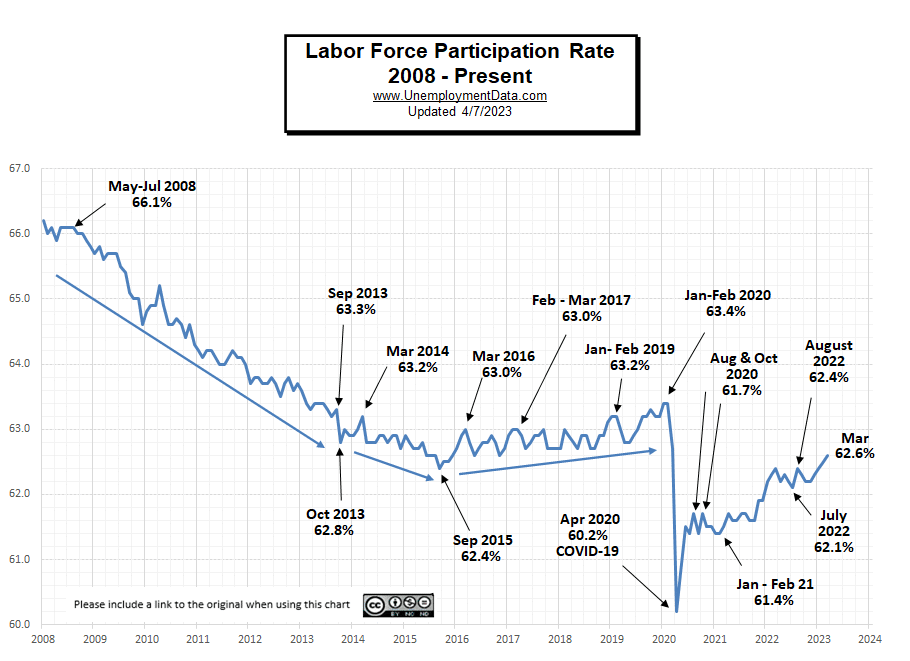 See Labor Force Participation Rate for more information.
See Labor Force Participation Rate for more information.
Seasonally Adjusted U1 through U6 Unemployment Rates
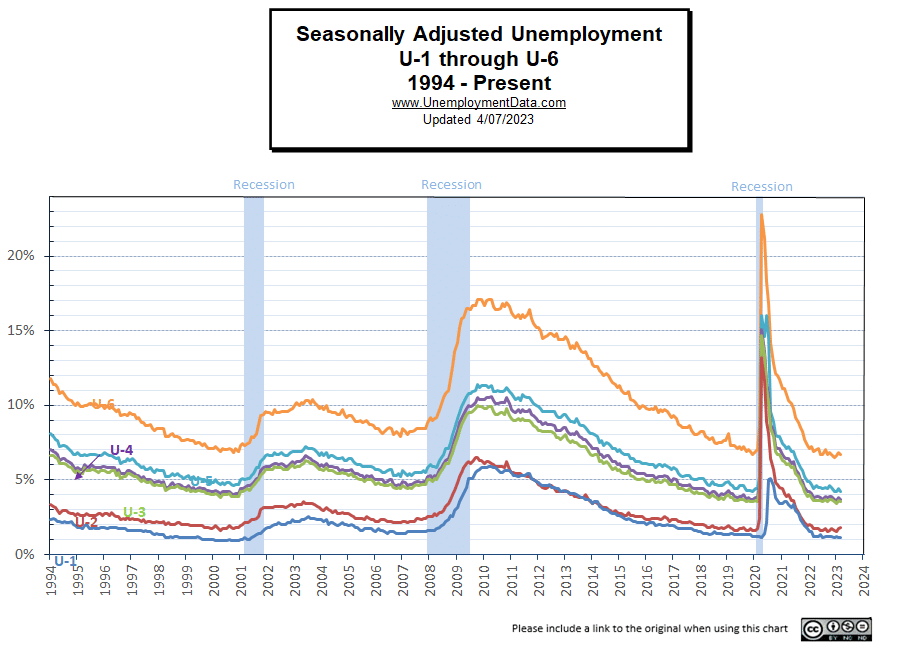 For more information about the various measurements of unemployment, see What Is U-6 Unemployment?
For more information about the various measurements of unemployment, see What Is U-6 Unemployment?
Seasonally Adjusted Unemployment by Education
Last month we saw a drastic increase in unemployment by the uneducated, jumping from 4.5% in January to 5.8% in February. This month it fell back to 4.8%. But High School grads rose to 4%.
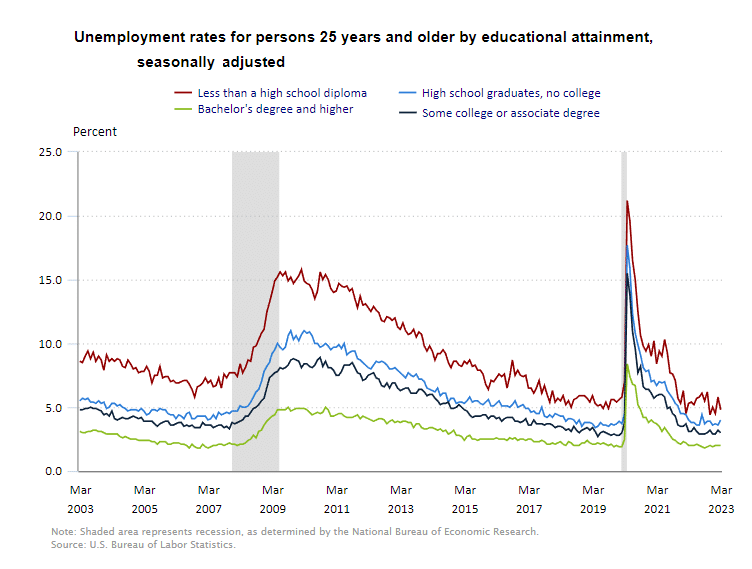 Employment-Population Ratio
Employment-Population Ratio
In March, 60.4% of the population was employed, up from 60.2% in February.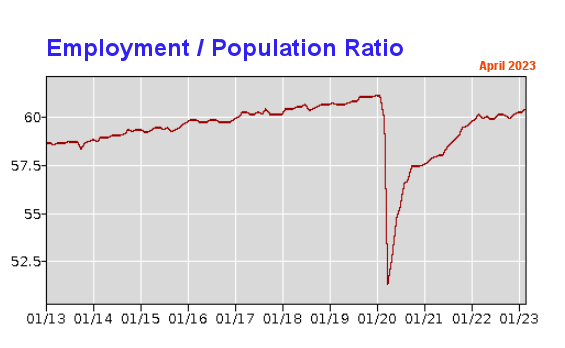
See Employment Population Ratio for more information
Read more on UnemploymentData.com.
- 5 Must-Know Tips for Optimizing Your Job Search
- February 2023 Unemployment Report
- Why Becoming a Flooring Installer is a Stable Career Path
- Strategies for Conquering Job Search Frustration
From InflationData.com
- The 3 Major Causes of Bank Problems
- Central Banks Respond Differently to the Banking Crisis
- Stock Market Ignores Lower Inflation in February
- How Loose Monetary Policies Cause Recessions
- Food and Shelter Prices Keep Climbing as CPI Growth Hits a Three-Month High
From Financial Trend Forecaster
- Moore Inflation Predictor
- NYSE ROC
- NASDAQ ROC
- Stock Market Outlook – March 24, 2023
- More Cracks in U.S. Dollar Dominance
- Do “Red States” Ride the “Blue State” Gravy Train?
- Has the Stock Market Turned Positive?
From Elliott Wave University
- Silicon Valley Bank, Silvergate and “The Everything Bust”
- Bull Trap or Market Consolidation?
- 60% stocks, 40% bonds? Ha!
- U.S. Dollar: Has the Mainstream Been Way Too Confident?
- Banks Are Becoming More Cautious About Lending
From OptioMoney.com
- Top Personal Finance Apps of 2023
- How to Deal with Financially Irresponsible Family Members
- How to Financially Prepare for a Baby
- 6 Ways to Cope with Bad Financial Decisions
- Simple Ways to Save Money When Shopping Online
From Your Family Finances

